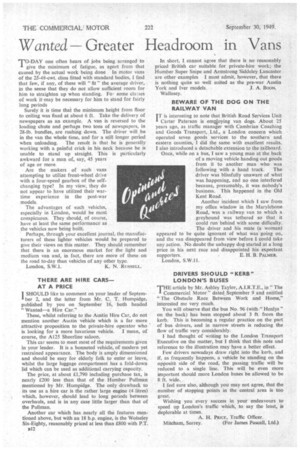Wanted Greater Headroom in Vans
Page 46

If you've noticed an error in this article please click here to report it so we can fix it.
TO-DAY one often hears of jobs being arranged to I give the minimum of fatigue, as apart from that caused by the actual work being done In motor vans of the 25-4c3-cwt. class fitted with standard bodies, I find that few, if any, of these will " fit " the average driver, in the sense that they do not allow sufficient room for him to straighten up when standing. Fo.some classee of work it may be necessary for him to stand for fairly long periods Surely it is time that the minimum height from floor to ceiling was fixed at about 6 ft. Take the delivery of newspapers as an example. A van is reversed to the loading chute and perhaps two tons of newspapers, in 28-1b. bundles, are rushing down. The driver will be in the van the whole time, and for a still longer period when unloading. The result is that he is generally working with a painful crick in his neck because he is unable to stand up straight. This is particularly awkward for a man of, say, 45 years of age or more.
Are the makers of such vans attempting to utilize front-wheel drive with a four-speed gearbox of the selfchanging type? In my view, they do not appear to have utilized their wartime experience in the post-war models.
The advantages of such vehicles, especially in London, would be most conspicuous. They should, of course, have at least the same performance as the vehicles now being built.
Perhaps, through your excellent journal, the manufacturers of these lighter vehicles would be prepared to give their views on this matter. They should remember that there is an enormous market for the light and medium van and, in fact, there are more of these on the road to-day than vehicles of any other type.
London, S.W.1. K. N. RUSSELL. In short, I cannot agree that there is no reasonably priced British car suitable for private-hire work; the Humber Super Snipe and Armstrong Siddeley Lancaster are other examples I must admit, however, that there is nothing quite so well suited as the pre-war Austin York and Iver models. • J. A. BOON. Wallasey.
BEWARE OF THE DOG ON THE RAILWAY VAN IT is interesting to note that British Road Services Unit
Carter Paterson is emloying van dogs. About 25 years ago, as traffic manager with Cambrian Coaching and Goods Transport, Ltd., a London concern which operated seven goods services to the southern and eastern counties, I did the same with excellent results. I also introduced a detachable extension to the tailboard.
Once, while on a bus, I saw a young man at the back of a moving vehicle handing out goods from it 10 another man who was following with. a hand truck. The driver was blissfully unaware of what was happening, and no one interfered because, presumably, it was nobody's business. This happened in the Old Kent Road.
Another incident which I saw from my office window in the Marylebone Road, was a railway van to which a greyhound was tethered so that it could run behind with some difficulty. The driver and his mate (a woman) appeared to be quite ignorant of what was going on, and the van disappeared from view before I could take any action. No doubt the unhappy dog started at a long price in his next race and disappointed his expectant supporters. E. H. B. PALMER. London, S.W.11.




















































































